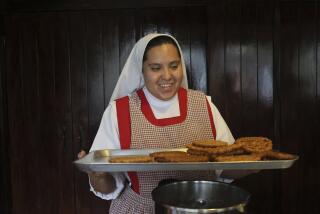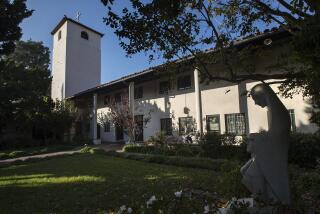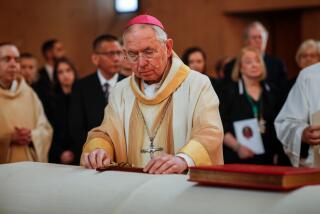Founder of High Desert Abbey Leaves Legacy of Faith, Adventure
- Share via
VALYERMO — The richness of Father Vincent Martin’s world can be seen in his 4-inch-by-3-inch black leather address book.
Its robin-egg blue pages are neatly filled with the addresses of the famous: a countess here, a cardinal there, a glamorous Hollywood celebrity.
Many other names are lesser known, but equally precious: simple monks, family in Brussels, colleagues in China, lifelong friends in Israel.
Father Vincent, who died Tuesday at 87, is best known for his founding of St. Andrews Abbey, which opens its doors once a year to the public to sell its famed ceramic images of saints and angels.
But among the monks at the abbey, nestled between the High Desert and the San Gabriel Mountains near Littlerock, he is remembered as someone who knew wealth as well as poverty. He relished vigorous theological debate and plunged himself into foreign cultures.
It was his constant thirst for knowledge--and the globe-galloping soul of an adventurer--that made it easy for Father Vincent to call the world his home.
And it was his faith as a Benedictine monk that sustained him through a Japanese POW camp, the growing pains of starting a monastery in 1955 at a former Antelope Valley turkey ranch and his barrier-breaking appointment as the first Catholic chaplain at Cedars-Sinai Medical Center.
Father Vincent’s monastic life began in 1928 when he joined the Benedictines at the Abbey of St. Andrew in Bruges, Belgium. Shortly after his ordination in July 1936, he and two other monks left their native Belgium to open a monastery in China.
When war broke out, Father Vincent became chaplain to the Chinese Christian soldiers who hunkered down with him as the Japanese bombed the countryside.
Later, after narrowly escaping execution in a Japanese POW camp, Father Vincent staved off boredom by learning English and Russian from fellow prisoners. Then with the war’s end, Father Vincent took up new duties as a Chinese liaison officer for the U.S. Marines.
Sister Karen Wilhelmy, a longtime friend, said the war left some imprints on Father Vincent that surfaced periodically.
Once at a restaurant, she watched as he carefully carved “every last fiber” of meat off a bone. Her brother asked if he should order another meal for Father Vincent, but Sister Karen shrugged it off, and explained he never wasted a morsel of food after his experience as a prisoner of war.
After the war, Father Vincent traveled to the United States and attended Harvard University, earning master’s and doctoral degrees in sociology.
But one of his most challenging assignments was in 1955, when the abbey in Belgium called with a request: Go to California. Set up a monastery. And here’s $50,000 to do it.
The search was exhausting, from Long Beach to Santa Barbara, and across Los Angeles.
As was often his style, Father Vincent turned a challenge into an improbable opportunity.
The only affordable and appropriate property was a 720-acre turkey ranch in a desolate High Desert valley in the San Gabriel Mountains.
“If it wasn’t for Vincent we wouldn’t have what we have,” recalled Brother Dominique Guillen. “It was he who did the legwork, it was he who did the negotiations. It was he who searched out over 200 properties.”
It was also Father Vincent who initially did not tell the ranch’s seller that he was a Benedictine monk seeking a property to start a monastery, fearful the owner might raise the price or object to the ranch’s new nonsecular life. But his conscience won out, and when he told the seller she threw in some furnishings that helped the fledgling abbey, Brother Dominique said.
In a 1993 Times interview, Father Vincent described the abbey, a collection of former ranch buildings and newer simple structures, as an “island of sanity” that attracted people “like they were coming for clear water.”
Surrounded by a blaze of mustard-colored cottonwoods and elegant poplars, the abbey has grown over the years.
Of the eight founding fathers--seven from Belgium and one from Indonesia--only two are still alive, Father Eleutherius Winance, 90, and Father Werner de Morchoven, 86.
Father Vincent’s death will be felt in many religious circles, local leaders say.
A longtime scholar of Israel, he lived in Jerusalem for 10 years, studying at Hebrew University and at the Ecumenical Institute at Tantur.
After his return to the United States, Father Vincent, fluent in both the scholarly and cultural knowledge of Judaism, was selected in 1977 as the first Catholic chaplain at Cedars-Sinai Medical Center. He also served on many joint Catholic-Jewish committees and commissions, recalled Rabbi Norman Pauker, who retired from the Mishkan Israel Congregation of North Hollywood.
During the High Holy Days, Rabbi Pauker said Father Vincent would come to Mishkan Israel and read from a Hebrew prayer book.
But his fondest memory was their first meeting 28 years ago at a joint Catholic and Jewish gathering in Los Angeles. Rabbi Pauker sat alone at a table with kosher food. No other rabbi or priest sat with him. “Father Vincent came to join me,” he remembered Wednesday. “That was how our friendship began.”
Father Vincent’s scholarly writings also explored the relationship between Christianity and Judaism, most notably his 1995 book “A House Divided--The Parting of the Ways between Synagogue and Church” and his 1998 booklet “Israelis and Palestinians At A Crossroads” dedicated to actress Jane Wyatt.
It was, however, probably Father Vincent’s one-on-one relationships that may have forged his most powerful influences on Christian-Jewish relations.
Years ago at Cedars-Sinai, on the first night of Hanukkah, a patient wanted to light the first candle. Father Vincent fetched a candle, brought it up to him, and stayed to share those special moments. “He told me about it in a nonchalant way the next day,” said Rabbi Levi Meier, a chaplain at the hospital.
With its starkly beautiful isolation, the Valyermo monastery served as base camp for Father Vincent’s travels to Israel and China, his teaching at UC Santa Barbara, and his writings.
Father Vincent’s world extended far beyond the walls of the monastery. “I speak in English, think in French, move in Jewish circles and dream in Chinese,” he once said.
Indeed, it was also that internationalist mind-set that served him--and the monastery--well.
It was summer 1984 and a Chinese Benedictine brother had been imprisoned for 26 years in China for his religious beliefs. The St. Andrews Abbey in Valyermo wanted to get him out, but how, they wondered?
The answer was closer than they ever dreamed.
Someone suggested the monks make a direct inquiry to Arthur W. Hummel Jr., then-ambassador to China.
“I know Arthur, we were in prison together,” Father Vincent said in a matter-of-fact voice.
With that POW connection, the path was paved to secure Brother Peter Zhou Bangjiu’s release and visa. Today, the brother still resides at St. Andrews.
Several years ago, Father Vincent was able to realize a long-held dream of returning to China after an absence of more than 50 years, Abbot Francis Benedict said.
In his typical energetic manner, Father Vincent threw himself into brushing up on the language. Upon arrival, he traveled around the country, renewing friendships separated by war and politics.
Just two months ago Father Vincent returned again to China, spending six weeks as the solo foreigner in a university hostel, Abbot Francis recalled with a laugh.
“I met up with him in China for three days,” he said. “He wanted to be 100% American in America, 100% Chinese in China and 100% Jewish in Israel.”
Father Vincent’s survivors include a brother, Pierre, of Namur, Belgium, and a niece, Marie Jeanne Martin, of France.
Services are 3 p.m. Sunday at the St. Andrews Abbey in Valyermo.
More to Read
Sign up for The Wild
We’ll help you find the best places to hike, bike and run, as well as the perfect silent spots for meditation and yoga.
You may occasionally receive promotional content from the Los Angeles Times.






